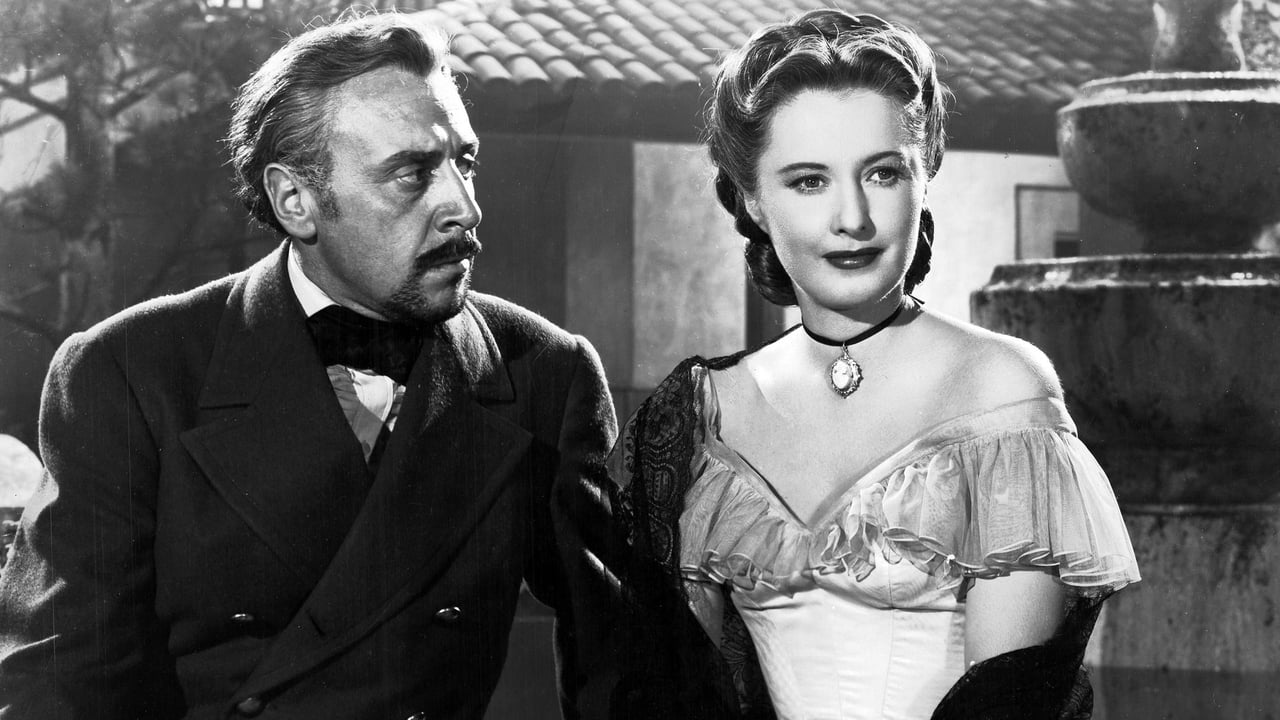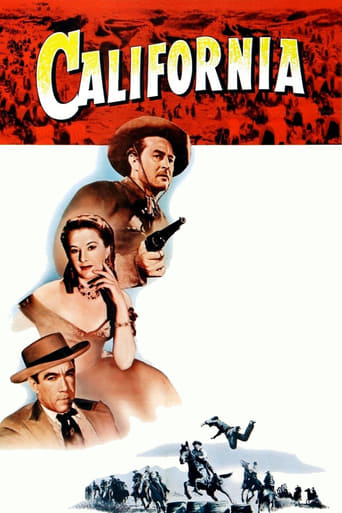

Director: John Farrow. Producer: Seton I. Miller. Copyright 21 February 1947 by Paramount Pictures Inc. New York opening at the Rivoli: 14 January 1947. U.S. release: 21 February 1947. U.K. release: 14 April 1947. Australian release: oddly no official release date despite the fact that this was one of Paramount's prestige releases of the year. Sydney opening at the Prince Edward: 18 April 1947 (ran four weeks). 8,758 feet. 97 minutes.SYNOPSIS: A former slave trader's plans to make California his own empire are thwarted by a moralistic army-deserter and an idealistic grape-grower.NOTES: Stanwyck's first color film. Filmed on locations (including Sedona) in Arizona.COMMENT: Much admired by many critics, including my colleague Barrie Pattison who swears that California is "one of the supreme achievements of mankind". I am of a lesser opinion. True, Farrow's direction is wonderfully fluid, with at least four or five extremely long, extremely elaborate and complicated one-takes. But their dramatic impact is often dissipated by a faulty script which lets Farrow down on a number of fronts: Firstly, the narrative construction is oddly episodic, with various segments separated by surrealistic chorales. Now I'm all in favor of experimentation in the cinema, but it doesn't gel here. All this extolling the virtues of California by an off-camera chorus ("Get my bible and banjo... It's California, or bust!"), doesn't always sit too well with a petty tale of a gambling hussy on the wagon train. (Of course not all the singing is done off-camera. The wagon folks themselves render "I Should Have Stood in Massachusetts", while saloon singer Stanwyck — wearing gorgeous gowns — is expertly dubbed for "Lily-I-Lily-I-Oh" and the haunting ballad, "Said I To My Heart, Said I"). The second problem with the script is that, despite its length, characterization is so sketchy, it's hard to get involved with the principals. Milland doesn't help much. Acquits himself well enough in the action spots, true, but otherwise just glumly rattles off his lines. Stanwyck plays with more fire in her spirit, and looks mighty fetching in Technicolor, but the script gives her such threadbare cloth to fashion, it's no surprise her performance makes little impression. Ditto Barry Fitzgerald. The one player who does come across strongly is George Coulouris who makes his Captain Coffin not only truly menacing, but even truly human. Yet even here the script tries to undermine the character (what a pity the haunting of naked feet pattering across the deck is only alluded to but once). Fortunately, such is Coulouris' skill he manages to force our interest interest upon the captain right through to his anticipated end. The other villains are distinctly minor by comparison, but Dekker and Muir manage them ably.The script's third vice is its overly verbose dialogue. Practically all of Fitzgerald's part could go with no loss of interest or continuity, and the scissors could likewise be taken to some of the principals' exchanges, plus three or four small but unnecessary scenes. Alas, in the print under review, Rennahan's once-lustrous color photography is now somewhat less than satisfying. Some superb images remain, however. The panning shot of all the furniture thrown from the wagons to facilitate the gold rush, for example. A flawed film, but still vastly entertaining. Superb sets, and unstintingly lavish production values help.
... View MoreAt first, it's a "How the West Was Won" journey of settlers heading to California (with a banjo on their knee), then it's about the gold rush. then a gambling hall, and finally a political squabble over statehood and impending civil war. And as much as it looks like a Cecil B. DeMille epic, it isn't, directed instead by John Farrow.But, oh, what a pleasure it is to look at, starting off with a travelogue like prologue with an E.Y. Harburg song. Barbara Stanwyck makes her entrance being tossed out of town by the proper ladies and gentlemen and reluctantly being picked up by the wagon train lead by Ray Milland. He doesn't want her on it, but feisty Barry Fitzgerald sympathizes with her and takes her along in his wagon. Then, news of gold breaks, everybody scrams, and Milland and Fitzgerald are left to themselves, surrounded by the junk yard of the journeyer's furniture left behind, the west coast's first garbage dump.It continues with an obviously dubbed Stanwyck singing a song in a gambling hall she's purchased, getting involved with ruthless Albert Dekker and alternately insulting and defending Milland while secretly supporting Fitzgerald for senator, Dekker's rival. It's the last segment that's the most interesting, a fictionalized vision of early California before swimming pools and movie stars, not to mention ski resorts, Hollywood signs, freeways and governators.Stanwyck gets to wear some bewitching gowns by Edith Head and is alternately tough, tender and tempestuous. Wasted in a tiny role, Anthony Quinn is nevertheless handsome in his brief dance with Stanwyck, historically important to see two legendary stars together. They would share more scenes in 1953's melodramatic "Blowing Wild". Milland is grizzled enough to take away the image of him in tailored suits from past movies (even though the same year he got his ear pierced by Marlene Dietrich in "Golden Earings") while Fitzgerald gives a performance filled with wisdom, heart, and humor.Colorfully filmed, this is still an interesting account of the settling of a land once wild, now overcrowded, yet still filled with beauty where cities have not yet risen.
... View MoreThe movie is a stab at an epic western that simply fails to gel. The best part is the "moving west" scenes of wagon trains convoying across the open southwestern terrain. These achieve an epic feel that the dramatics unfortunately fail to duplicate. The screenplay itself is pretty crowded, telling the story of California's becoming a state, no less. From settlers to gold rush to saloons to political intrigue, the story is traced out mainly through Milland, Stanwyck, and Coulouris, with Fitzgerald as a salt-of-the-earth anchor.Now, that might work, except director Farrow has little feel for the material. The various parts come across in rather limp, unexciting fashion. It's as if he's content to simply film the script without bringing its many conflicts to dramatic life. Thus, the drama is conveyed in words instead of characters. Then too, Oscar winner Milland appears either miscast or uninspired. His role really calls for a bigger personality than Milland's generally low-key wagon master. (He may have viewed a western as a comedown after his award winning role in The Lost Weekend.) Stanwyck is of course Stanwyck even though she's dolled-up to suit Technicolor filming and crowded around by the packed screenplay . Too bad the guy who could have enlivened the action remains in supporting background, namely, the commanding Albert Dekker (Pike).Anyway, I guess I now know why this epic western remains so obscure, despite its Paramount pedigree and marquee cast.
... View MoreArmy deserter Ray Milland leads a wagon train, including woman-of-easy-virtue Barbara Stanwyck, on its way to California, only to find the gold rush in full effect and the territory overrun by scoundrels, like megalomaniac slave-ship captain Barry Fitzgerald.The excellent photography, with equally excellent use of Technicolor, good direction by John Farrow, and Milland's brooding can't quite overcome the overly talky script, the datedness of the songs, and the fact that Stanwyck's character is quite unappealing most of the time.However, for those of us who grew up watching Ray Milland playing old curmudgeons in various B-movies of the sixties, seventies, and early eighties, it's interesting to see him in his prime, playing a rugged leading man.
... View More